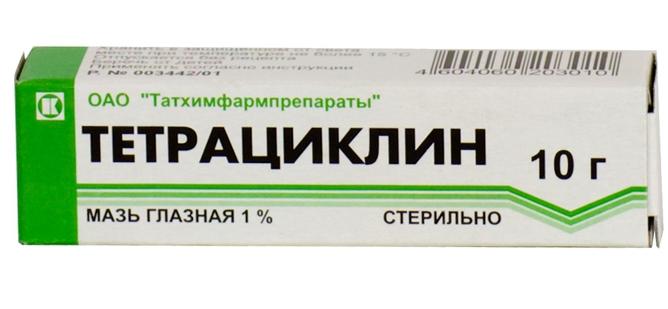Compound
| Composition of ointment Tetracycline, 100 g | |
| Active ingredients: | 3 g |
Shape-forming:
| up to 100 g |
The active tetracycline fights inflammation, including skin inflammation:
- Yellow ointment is produced in aluminum tubes of various sizes (3, 10, 15 or 30 g).
- It comes in 1 and 3 percent.
- Tubes of ointment are sold in packs along with instructions.
- The broad-spectrum antibiotic Tetracycline has a low price: for 15 g of the product - from 20 to 50 rubles.
- Its effectiveness will help against many eye diseases and even inflammation due to foreign bodies trapped in the visual organs.
Tetracycline ointment is available in sterile polymer and hermetically sealed jars of 400, 200, 100, 40, 20 and 10 g. This product can also be found in 500 g bottles, but in plastic containers with plastic screw caps. Moreover, 1 gram of the drug contains 30,000 units of the active substance - tetracycline hydrochloride. As for the additional components, these include: sodium pyrosulphate, paraffin, petroleum jelly, ceresin and anhydrous lanolin.
- Active element: tetracycline hydrochloride (1 g.)
- The basis of the ointment is lanolin and petroleum jelly.
Externally, the drug is a viscous, homogeneous substance of yellow or light brown color with a specific medicinal odor.
Action
- Tetracycline is active against many pathogenic pathogens and is traditionally used to treat eye infections.
- This antibiotic has a strong bacteriostatic effect; it inhibits the growth, development and reproduction of microorganisms sensitive to it.
- Tetracycline eye ointment is used in ophthalmology for staphylococcal and streptococcal lesions of the conjunctiva and cornea.
The product is also active against: Haemophilus influenzae, Enterobacter, Klebsiella, Salmonella, Mycoplasma, Shigella, Triponema, Chlamydia.
The ointment is not prescribed for eye infections with viruses, fungi, or protozoa, since it has no effect on them. And also when the eye membranes are infested with hemolytic streptococcus, which is why this pathogen has developed resistance to tetracycline antibiotics.
Treating bacterial and chlamydial infections is what Tetracycline eye ointment is used for.
In relation to bacteria sensitive to tetracycline, the drug acts through the mechanism of bacteriostatic inhibition of their vital activity.
The antibiotic, penetrating into bacterial cells, inhibits the production of protein fractions, thereby depriving them of the opportunity to develop and divide.
How much the drug costs mainly depends on the dosage.
Tetracycline ophthalmic ointment (1%) is available in aluminum tubes with screw caps of 3,5,7,10 grams.
Accordingly, the price varies from 35 to 87 rubles.
This cheap drug is available at any pharmacy and can be purchased without a doctor's prescription.
What does it help with?
The drug has the following indications for use:
- inflammation of the conjunctiva (conjunctivitis);
- infection of the edges of the eyelids (blepharitis);
- simultaneous damage to the conjunctiva and eyelids (blepharoconjunctivitis);
- inflammation of the cornea (keratitis), its erosion and ulceration;
- combined infection of the cornea and conjunctiva (keratoconjunctivitis);
- damage to the meibomian glands (meibomitis, colloquially “barley”);
- chronic inflammatory ophthalmological disease - trachoma;
- ophthalmic rosacea - eye damage due to rosacea;
- thermal, chemical, radiation burns of the conjunctiva, cornea;
- eczema, boils located in the eye area.
The ointment is placed behind the lower eyelid 2-4 times a day.
Since the drug is not a dosed product, it is squeezed out of the tube in small portions, evenly distributed over the conjunctival mucosa.
Algorithm for applying ointment
- Wash your hands thoroughly.
- Take a horizontal position and with your left hand pull the eyelid towards you.
- Apply ointment (5-6 mg) to the inner surface of the conjunctiva, in the direction from the corners to the edge.
- Cover your eyelids and move your eyeballs in different directions; you can gently massage the entire eye area with your fingertips.
Treatment regimens
- For inflammation of the eyelids
- The course of therapy lasts 5-6 days, the ointment is used three times a day.
- For blepharitis in combination with conjunctivitis
- Treatment procedures are carried out 3-4 times a day, for a period of 6-7 days.
- For lesions of the cornea, including against the background of inflammation of the conjunctiva
Tetracycline ointment is prescribed for 5-7 days, with the ointment applied 2 to 3 times a day.
An indicator of the effectiveness of drug therapy is signs of improvement that appear no later than the 5th day of use of the drug.
- For barley
- The drug is used at night, the course of treatment is 4-8 days.
- Trachoma
This disease requires more intensive procedures, so the ointment is applied throughout the day, at intervals of 2-4 hours. The duration of therapy can be up to 2 months.
- Predisposition to allergies to tetracycline antibiotics.
- Eye infections of fungal origin.
- Herpetic eye lesions.
- The first three months of pregnancy, lactation period (breastfeeding).
For people who constantly use contact lenses, it is better not to use them at all during treatment with tetracycline ointment or to put them on an hour after the procedure.
The use of the ointment is accompanied by temporary blurred vision due to its oily base, so you can start driving vehicles only when it is completely clear.
Reactions to the drug
In the first days of using the ointment, people with sensitive mucous membranes may experience temporary (transient) symptoms of irritation:
- moderate redness;
- burning and itching;
- photophobia.
These phenomena disappear within a couple of days from the start of treatment.
If they become persistent, this may indicate that patients are allergic to the drug and need to urgently consult their doctor.
How to use the medicine
The method of application and frequency of use of tetracycline ointment depend on the disease.
Eye ointment for conjunctivitis and other eye infections is placed with a sterile cotton swab into the conjunctival sac and gently distributed with massaging movements along the outer side of the eyelid. The ointment should be used three to five times a day, for a course of five to seven days.
To treat skin pathologies, the ointment is applied to the affected areas once or twice a day. A sterile dressing can be applied on top, which needs to be changed every 12-24 hours. The duration of therapy is from several days to three weeks.
If the product is used to get rid of acne, then it should be applied pointwise.
Shelf life and storage conditions after opening
When closed, the drug presented in jars can be stored for no more than 3 years, and a printed aluminum tube can be stored for about 60 days. The most comfortable conditions for storage are rooms where the air temperature does not exceed 20 degrees. It is perfectly acceptable to keep the ointment in the refrigerator.
The sealed drug is stored for no more than 3 years in a dry, dark place, at a temperature of up to 15 degrees, away from children. The expiration date is usually indicated on the packaging. After Tetracycline ointment is opened, they try to use it for 5 weeks, no more. It is better to store the product already used in the refrigerator.
Description of the drug
![]()
What is Tetracycline ointment? Instructions for using this medication will be discussed in the following sections of the article. Now we will describe the properties of this drug. Tetracycline ointment is an antibacterial agent that has fairly broad damaging properties. The active substance included in its composition (tetracycline hydrochloride) is a universal antibiotic.
Contraindications and side effects
Tetracycline ointment (for which the drug helps is presented below) has a depressing effect on microorganisms such as:
- salmonella;
- E. coli;
- chlamydia;
- pneumo- and gonococci;
- mycoplasma;
- streptococci and staphylococci.

The molecules of the drug destroy microorganisms at the chromosomal level, due to which the disease quickly recedes and does not recur. But tetracycline ointment sometimes needs to be used in combination with other antiviral drugs.
The components of the product stop the growth and spread of bacteria, disrupting their intracellular synthesis. Tetracycline in the form of an ointment penetrates the skin better and fights pathogens.
Tetracycline ointment should not be taken:
- pregnant women in the 1st trimester;
- in the presence of hypersensitivity to the formative substances of the drug;
- patients with chronic or acute liver or kidney failure;
- breastfeeding mothers;
- children under 8 years old;
- patients with lupus erythematosus;
- with injury to the mucous membrane of the eye.
While undergoing therapy with this antibiotic, avoid all dairy products and foods rich in iron. Such food does not allow Tetracycline to fully activate.
For patients with hypertension who take vitamin A, this antibiotic is contraindicated due to the fact that it increases blood pressure. Before using the product, be sure to read the instructions for use of the drug.
The product is used with caution in relation to those suffering from hay fever and food allergies. Uncontrolled use of antibiotics further aggravates their condition.
When using Tetracycline ointment, it is important to remove all cosmetics before applying it to the face. The skin is cleaned and degreased with an antiseptic. During drug therapy, all lotions and tonics are removed from everyday use until the disease is cured. And although the simultaneous use of cosmetics and Tetracycline is not prohibited, it is better not to overload the skin with makeup.
![]()
Doctors sometimes allow the use of the drug for pregnant women and young children if it is impossible to find an analogue of this medicine. But this can only be done by specialists, not patients.
After medical consultation, it is important to follow the prescribed dosage and methods of use of the drug. Athletes taking special supplements, pregnant and lactating women should definitely see a doctor when treating with tetracycline ointment.
For newborns, the remedy, if prescribed by the pediatrician, is placed behind the eyelid in the required amount. After this, infants should be distracted with something so that they do not rub their eyes, since the drug irritates them after application. The ointment is applied to such children once a day.
Due to ineffective control against certain pathogens, Tetracycline is not used for:
- bacteroids;
- serations;
- Pseudomonas aeruginosa;
- viruses and fungi;
- allergies;
- rashes due to hormonal and age-related changes in the body.
Side effects from Tetracycline are as follows:
- small rash;
- severe itching;
- swelling and inflammation of the skin.

![]()
From an overdose and long-term treatment with the drug, the following may occur:
- migraine;
- insomnia;
- apathy and weakness;
- flatulence;
- nausea and vomiting;
- dysbiosis and bloating;
- candidiasis;
- fatty hepatosis in infants;
- lack of appetite;
- difficulty swallowing food;
- the occurrence of inflammation in the esophagus and tongue.
The therapeutic effect of the presented ointment is determined by the active substance. Once on the affected area of the skin or mucous membrane, the antibiotic begins to destroy all metabolic processes and the action of protein synthesis in the cells of microorganisms, blocking the restoration of cell walls, which results in stopping the division and further proliferation of bacteria.
Pharmacological effect of the drug
The drug "Tetracycline" is an antibiotic active against Chlamydia spp., Rickettsia spp., Spirochaetaceae, Mycoplasma spp., as well as gram-negative bacteria Bordetella pertussis, Neisseria gonorrhoeae, Escherichia coli, Enterobacter spp., Salmonella spp., Klebsiella spp. , Shigella spp., aerobic gram-positive bacteria Streptococcus spp. and Staphylococcus spp. (including strains that cause penicillinase).
Tetracycline is not effective against resistant Proteus spp., Pseudomonas aeruginosa, Serratia spp., most fungi and small viruses, as well as many strains of Bacteroides fragilis and group A beta-hemolytic streptococci.
The bacteriostatic effect of the antibiotic is achieved by suppressing the formation of pathogen proteins at the ribosome level.
Indications for use of 3% product
The drug is used for:
- barley;
- trachoma;
- conjunctivitis;

- trophic ulcers;
- acne and various rashes;
- boils and carbuncles;
- eczema;
- burns with bacterial infection;
- infected and bleeding hemorrhoids;
- advanced runny nose with green nasal discharge;
- bacterial ear infection.
Tetracycline eye ointment (1%) is often used to treat ophthalmic infectious and bacterial diseases such as:
- conjunctivitis in various forms;
- keratitis;
- trachoma;
- blepharitis.
Tetracycline ointment for cutaneous use (3%) is most often used when such abnormalities occur as:
- acne with purulent foci;
- viral eczema;
- streptostaphyloderma (that is, various acne that was caused by streptococci and staphylococci);
- folliculitis (that is, with infectious inflammation of the hair follicles);
- trophic ulcers.

Tetracycline ointment of any kind is contraindicated for fungal diseases, hypersensitivity to the active substance of the drug, as well as to antibiotics such as Doxycycline and Oxytetracycline. This drug should be used with extreme caution in case of leukopenia and kidney disease. Any Tetracycline ointment and other medications from this group should not be used by pregnant women and children under 8 years of age. Among other things, this drug is not recommended for use by those who are susceptible to various allergic reactions.
Indications and contraindications
Tetracycline ointment is used to treat the following diseases:
- conjunctivitis;
- acne;
- folliculitis;
- boils;
- burns;
- streptoderma;
- staphyloderma;
- trachoma;
- infectious blepharitis;
- keratitis;
- barley;
- trophic ulcers.
There will be no effect when using this remedy for allergic rashes, demodicosis of the eyelids, fungal infections, purulent wounds, viruses, Pseudomonas aeruginosa.
Tetracycline eye ointment should not be used if the body is highly sensitive to the active substance, as well as to components such as doxycycline and oxytetracycline. Tetracycline ointment for eye and skin diseases is contraindicated for women during pregnancy and lactation, and children under 8 years of age.
The use of tetracycline ointment at an age when the child is developing bone structures is also prohibited, since the antibiotic can provoke irreversible changes, disrupting the standard process in the child’s body.
Tests of tetracycline ointment for children have not been carried out, and the appropriate dosages of the drug have not been determined, as a result of which caution has appeared in its use. If there are any doubts about treatment with tetracycline ointment, pediatricians recommend using one percent instead of a three percent solution.
Particular caution should be used when using tetracycline ointment in the eyes or on the skin of those people who have had any allergic reactions previously. This drug should not be used for fungal infections. In case of low levels of leukocytes in the blood and chronic kidney disease, use the drug only as prescribed.
The simultaneous use of tetracycline with glucocorticosteroids enhances the effect of the latter. The active compound can be deposited on the dentin of tooth enamel in children if the ointment is used to treat skin diseases during teething. As a result, the enamel may darken.
When treating skin diseases, the medicine is applied to the affected area 1 - 2 times a day. Change the dressing every 12 to 24 hours. Duration of treatment – from several days to 2 – 3 weeks. The duration of therapy should be prescribed by a doctor, taking into account all the nuances.
In cases where Tetracycline ointment for acne is used, it is applied pointwise.
Contraindications and side effects
As a rule, Tetracycline ointment is well tolerated by patients. Although, like other antibiotic drugs that have a fairly wide spectrum of action, it can cause side effects such as:
- nausea;
- decreased appetite;
- vomit;
- intestinal upset (severe or mild diarrhea);
- changes in the mucous membranes of the oral cavity and gastrointestinal tract (for example, glossitis, stomatitis, gastritis, proctitis, etc.);
- allergic skin reactions, Quincke's edema, etc.
Side effects
Most often, the use of tetracycline ointment causes local allergic reactions, manifested in the form of itching, redness or burning. In this case, you should stop using the drug.
![]()
General reactions of the body are also possible, such as lack of appetite, nausea and vomiting, abdominal pain, constipation, diarrhea, inflammation of the tongue and esophagus. Rarely, Quincke's edema and increased sensitivity of the skin to sunlight occur. Long-term use of the product can cause candidiasis, dysbacteriosis, lack of B vitamins, a decrease in the number of platelets in the blood, and anemia.
The use of tetracycline eye ointment usually does not cause unwanted side effects. In rare cases, reactions similar to side effects from tetracycline treatment for skin conditions may occur. Possible manifestations of allergies, angioedema, vomiting, loss of appetite, diarrhea.
Manifestations of hypersensitivity to the drug and the occurrence of adverse reactions require discontinuation of use of this drug. If necessary, another antibiotic of similar effect may be prescribed.
Is the use of tetracycline ophthalmic ointment always indicated?
Features of the drug
Tetracycline ointment may increase the sensitivity of the skin to sunlight. It was also noted that long-term use of this ointment during the formation of teeth causes a dark yellow color in children. In addition, long-term use of this drug contributes to complications caused by the development of candidiasis.
During treatment of patients with Tetracycline ointment, their condition should be carefully monitored. If the first signs of hypersensitivity to the drug or side effects appear, it is necessary to take a break from treatment, and if urgently necessary, prescribe another antibiotic that does not belong to the tetracycline group.
Instructions for use of tetracycline ointment
How to use tetracycline ointment? A small amount of ointment, which is placed behind the lower eyelid of the affected eye up to four times a day. For skin diseases, the ointment is applied to the affected area or left under a bandage.
Sidebar: Side effects of tetracycline ointment: nausea, vomiting, changes in blood composition, liver and kidney damage, increased sensitivity to sunlight, damage to bones and teeth (with long-term use for children), allergies to the components of the drug.
Overdose of the drug - if side effects occur, immediately stop using it and consult a doctor.
No addiction to the drug develops.
Tetracycline ointment for newborns
![]()
Three percent ointment for cutaneous use (3%) should not be administered to infants. This is due to the fact that, entering the blood through the pores, this drug affects the color of the teeth, causing them to darken greatly. As for tetracycline ophthalmic ointment (1%), it is practiced in the treatment of newborns only for some ophthalmological diseases.
However, it must be used only as prescribed by a doctor and in the dosages prescribed by him. Thus, the question of whether Tetracycline ointment can be used for newborn children can only be answered by an experienced pediatrician after determining the child’s propensities for allergic reactions, hypersensitivity and individual intolerance.